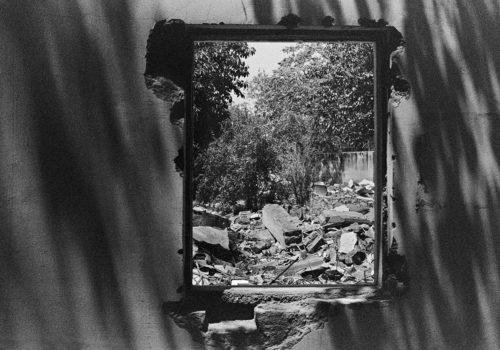After demonstrating the Tenderness of Le Corbusier’s Concrete French ambassador to Delhi and passionate photographer Emmanuel Lenain is presenting another of his camera investigation in India’s urbanization, as in “when man turns his back, nature strikes back”. Using deliberately the reference to one episode of Star Wars “The Empire Strikes Back” he wanted to emphasize the forceful revenge of nature to man’s urbanization. This is a series of forty-one black and white photographs showing how trees, vegetation, tree roots and vines grow wild with a vengeance, in cities and buildings in India. As a contrast to the structural, geometric and rational vision of Le Corbusier’s architecture and urban planning from his previous exhibition, that gives a sense of quasi apocalyptic end-of-the-world landscape as depicted in cinema and television series. Emmanuel places the man versus nature dialectic in front of us and explores how photography can seize the moment when chaos takes over. If structure and order are the faces of the above world then chaos would summarize what could be the underworld (original meaning of chaos in Greek: abyss). To quote Emmanuel, “In big urban centers, we can only see (nature) in fleeting glimpses through gaps, in an almost cinematographic way. But everywhere we see her ready to reclaim her rights. As soon as humans let go a little, vines appear right in the middle of buildings, trees grow vertically on facades, vehicles get covered with plants.”
The most striking one is this hole in the wall, a window or a mirror framing a sort of “screen capture” of the oldest cemetery in India, the Jadid Qabristan Ahle Islam cemetery in New Delhi, that has served as a designated burial ground for victims of Covid. In a composition that calls to mind Marcel Duchamp’s ultimate installation: “Étant donnés: 1. La chute d’eau, 2. Le gaz d’éclairage” (1944-1966) where viewers are invited to look through a pair of peep holes, to see a body holding a lamp lying on a bed of twigs on the fringe of a seemingly wooded landscape. Could Duchamp have predicted how nature would ultimately win over humans and erase all their tokens of civilization?
Another surreal scene depicts huge columns of earth in a sort of quarry carved out by bulldozers or excavators forming a Buren-like truncated column, on top of it stands a lone tree, like those resistant households called “nail-houses” that stubbornly refused their eviction from urban re-development projects in China. This lone tree stands out as a banner of the last fighter ready to strike back.
It is not a simple dialectic between man and nature, Emmanuel Lenain in his previous job has seen how the high-speed growth and urban development have disfigured China’s towns and cities. Whereas in India, traveling across eighteen cities, he would see the subtle and not-so-subtle signs of nature’s revolt from Kolkata to Chandernagore, from Mumbai to the holy city of Varanasi. Varanasi or Benares is the holiest city in India (for Hindus and Buddhist alike), where Siddhartha Gautama the Buddha has delivered his first sermon about the Four Noble Truths (the truth of suffering, the truth of the cause of suffering, the truth of the end of suffering, and the truth of the path that leads to the end of suffering). Emmanuel’s camera captured a mesh of roots of a monstrous giant banyan tree twisting and turning, struggling to sprout out from a cascading brick wall. Is that the same banyan tree under which Siddhartha attained enlightenment? Goethe did say “all perishable things are mere symbols” or “all that is transitory is but a metaphor”, a perfect expression of the transitory “nature” of human beings, and of man’s buildings, compared to the eternal cycle of death and rebirth of nature.
A reminder: this conflict between unbridled development and revengeful nature will end in an uncertain outcome because of a third actor: climate change, which will upset the whole deal.
Jean Loh
An exhibition at the Contemporary Art Gallery, Bihar Museum, Patna Bihar India from June 22 to July 22, 2023, ahead of the August Bihar Biennale www.biharmuseum.org
Previous exhibition TENDER CONCRETE at Government Museum of India in Chandigarh, from April 18 to June 30, 2023.
















